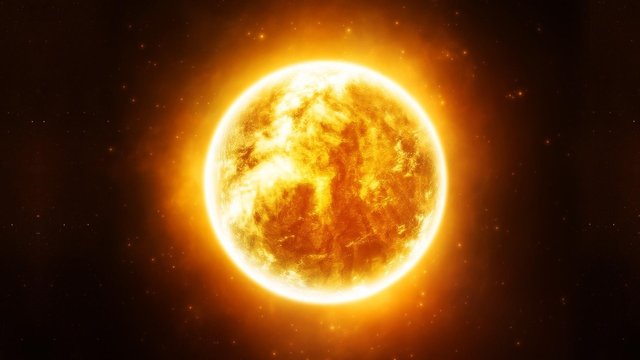Our Solar System - The Sun #2
The core of the sun extends from the center to about a quarter of the radius of the sun. Although it accounts for only 16 percent of the volume, about half of the sun's mass is concentrated here, at a temperature of about 15 million degrees Celsius and a pressure of several tens of billions of Hectopascals, the air pressure corresponding to about one Hectopascals.
Here, hydrogen nuclei fuse to form helium nuclei. These helium nuclei have a slightly smaller mass than the original hydrogen nuclei and it is this mass difference that is converted into energy according to Albert Einstein's theory of relativity and the famous formula E=mc².
In the core of the sun, 700 million tons of hydrogen are fused into 695 million tons of helium per second, and yet the core of the sun is actually too cold for nuclear fusion.
The kinetic energy of the particles is not sufficient to overcome the strong repulsive forces of the positively charged hydrogen nuclei in the event of a collision. The fact that the engine is still running is due to quantum mechanical tunnel effects. In this way, the hydrogen nuclei can overcome the electrical repulsion. The probability of this happening is low. But because an immense number of hydrogen nuclei are present, enormous amounts of energy can still be released.
This slowed down nuclear fusion is of crucial importance for the solar system and life on earth. Because the sun uses its energy reserves sparingly, it can radiate constant amounts of energy over a long period of time.
Around the core lies the so-called radiation zone, which accounts for about 70 percent of the sun's radius. This is where the radiation generated in the core is slowed down. Statistically, a photon, a light particle or light quantum takes 170 thousand years to pass through this radiation zone. The light that we receive today from the sun was created at a time when our ancestors still regarded the fist wedge as high-tech.
With every collision in the radiation zone, the radiation energy of the proton decreases and its wavelengths increase. Thus, the high-energy gamma radiation in the nucleus first becomes X-ray light, then UV radiation and finally visible light.

 Part 1
Part 1 

 Part 3
Part 3 


How do you define 1 second at a temperature of about 15 million degrees Celsius and a pressure of several tens of billions of Hectopascals ?
Hello @oendertuerk to the end is quite strange the mutual relationship that exists between living beings, the planet earth and the sun...
Hello @oendertuerk I have been very useful your post thank you for giving us your point of view...
Hi, @oendertuerk!
You just got a 1.22% upvote from SteemPlus!
To get higher upvotes, earn more SteemPlus Points (SPP). On your Steemit wallet, check your SPP balance and click on "How to earn SPP?" to find out all the ways to earn.
If you're not using SteemPlus yet, please check our last posts in here to see the many ways in which SteemPlus can improve your Steem experience on Steemit and Busy.
Hi @oendertuerk!
Your post was upvoted by @steem-ua, new Steem dApp, using UserAuthority for algorithmic post curation!
Your UA account score is currently 4.935 which ranks you at #1166 across all Steem accounts.
Your rank has improved 14 places in the last three days (old rank 1180).
In our last Algorithmic Curation Round, consisting of 181 contributions, your post is ranked at #30.
Evaluation of your UA score:
Feel free to join our @steem-ua Discord server